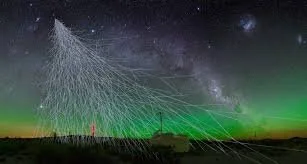There’s a huge mix of topics in this week’s post, from flavor physics and violations of lepton universality, to CMB balloon experiments, to black hole images. Enjoy the read!
Top arXiv papers from Week 39, 2020
Top arXiv papers from Week 29, 2020
Top arXiv papers from Week 28, 2020
Top arXiv papers from Week 25, 2020
This week is a bit special, and I have been debating with myself for some time whether I should have talked about the XENON electronic recoil excess we all have heard about, reported in 2006.09721 (this inner debate is one of the reasons behind my delay). Ordinarily I would have done so, but this time I opted for no, simply because there is much better coverage on the XENON result out there than anything I could possibly produce (needless to say many other popular science articles on the XENON results are instead pure junk). Natalie Wolchover is probably one of my favorite scientific journalists (by far the best among the ones I have interacted with), so for those interested in an excellent coverage of the XENON result, I recommend her piece on Quanta Magazine. Having said that, I’ve devoted this week’s entry to a new measurement of H0 from the Baryonic Tully-Fisher relation, a new neutrino mass forecast for cosmology taking into account a very subtle effect on the galaxy bias, and a study of the shadows of rotating regular black holes.
Top arXiv papers from Week 19, 2020
This week’s entry features a futuristic way for obtaining a direct geometrical measurement of the Hubble constant using the so-called cosmic secular parallax, a study on the possibility of cross-correlating ultra-high energy cosmic rays and large-scale structure and what we would learn from this cross-correlation, and the second-best constraint on the tidal charge of brane-world black holes from the shadow of M87* detected by the Event Horizon Telescope. Enjoy!
Top arXiv papers from Week 16, 2020
This week’s entry discusses two papers on shadows (one in relation to superradiance, and one in relation to naked singularities), and one paper addressing the important question of how model-independent BAO measurements are. Following the discussion of the third paper, I have included a long-ish bonus discussion on what my opinion is on this whole BAO model-independence business (some readers might find the discussion provocative, if so that was not my intention). Enjoy!
Top arXiv papers from Week 15, 2020
This week’s entry focuses on observational tests of a specific class of string inflationary models (which allow to set limits on the fundamental microscopic string parameters), observational tests of naked singularity spacetimes from their shadows and the continuum spectrum emitted from accretion disks, and finally a study addressing the interesting question of what was the maximum initial temperature of the Universe in the radiation domination epoch. Happy Easter to those readers who celebrate it!
Top arXiv papers from Week 14, 2020
This week’s entry features a new ACT CMB lensing cross BOSS CMASS galaxies cross-correlation measurement implementing a new tSZ-cleaning procedure, a new update on the H0 tension and in particular how fifth forces could lower the TRGB-calibrated measurement (besides the usual Cepheid-calibrated one), and finally the return of black hole shadows (in asymptotically de Sitter spacetime). Enjoy and stay safe!
Top arXiv papers from Week 9, 2020
In this week’s summaries I look at vector-tensor Horndeski gravity (the lesser known sibling of scalar-tensor Horndeski gravity), the (im)possibility of solving the Hubble tension with late-time transitions in the dark energy, and a reconstruction of the time-dependent interaction between cold dark matter and vacuum energy. Note the possibility that next week’s entry might be cancelled or in the best case delayed (see my away note).










